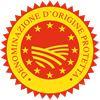Description
Pancetta Piacentina PDO is a charcuterie product obtained from the so-called "pancettone", a fatty cut of pork. The meat comes from the Italian Large White, Landrace and Duroc pig breeds, or other similar breeds compatible with the Italian heavy pigs.
Production Area
The production area of Pancetta Piacentina PDO is within territory in the Province of Piacenza, in the Emilia-Romagna region, situated up to 900 metres above sea level. The pigs used for processing have to be born, reared and slaughtered in the regions of Lombardy and Emilia-Romagna.
Production Method
After the meat is selected, it is cut into squares, trimmed and left in the refrigerated cells until salting. The bacon is dry salted by hand, using a mix of salt, pepper and spices. The salted product is then left in a refrigerator for a minimum of ten days. After being scraped, the bacon is rolled and tied, attaching natural pig casings at the ends of the roll or on the side seam; lean pork may be also be added. The product is dried and cured for a minimum period of four months, commencing from the salting date, in environments with temperatures ranging between 10 and 18°C and a humidity level of 70-90%. The production processes take place in areas that do not exceed an altitude of 900 m.
Appearance and Flavour
Pancetta Piacentina PDO has a cylindrical shape and weighs between 4 and 8 kg; the slice is bright red in the lean parts and white in the fat parts. The meat has a pleasant and sweet fragrance. The slice is soft on the palate, tending to melt in the mouth thanks to the presence of the fat, which also determines the delicate and remarkably mild characteristic savoury flavour.
History
The first traces of pig farming in the production area of Pancetta Piacentina PDO date back to one millennium B.C. Evidence was subsequently found in Roman civilization, with archaeological finds such as a bronze talisman-pendant showing a small pig. Depictions of this animal can be found in the Abbey of San Colombano a Bobbio, in Val Trebbia, where it is possible to admire a mosaic from the XII century, portraying the “sacred” rite of pig slaughtering. At the beginning of the XV century, Milan and Lombardy tradesmen were already able to distinguish Piacenza charcuterie from those coming from other places within the Po valley, qualifying them as “roba de Piaseinsa” (stuff from Piacenza). Subsequently, in the first decades of the XVIII century, Piacenza charcuterie were also appreciated in elite French and Spanish environments, thanks to a skilful diplomat from Piacenza, Cardinal Giulio Alberoni. During the last century, the local processing of meat began to take on a semi-industrial form, however, notwithstanding the passing of time and progress in technology, company’s continue to produce this product with traditional methods linked to customs passed down from generation to generation.
Gastronomy
The best way to preserve Pancetta Piacentina PDO is to keep it in the fridge, after having carefully washed the rind and wrapped it in a damp cloth. Traditionally it is eaten raw as an entrée, either with other charcuterie products or as an ingredient in the Piadina Romagnola PGI. It is also excellent cooked and is used as an ingredient in many outstanding recipes in Italian cuisine.
Distinctive Features
In contrast to other bacons, Pancetta Piacentina PDO is rolled, a characteristic that is evident in the cut slice which presents alternating circular layers.




























